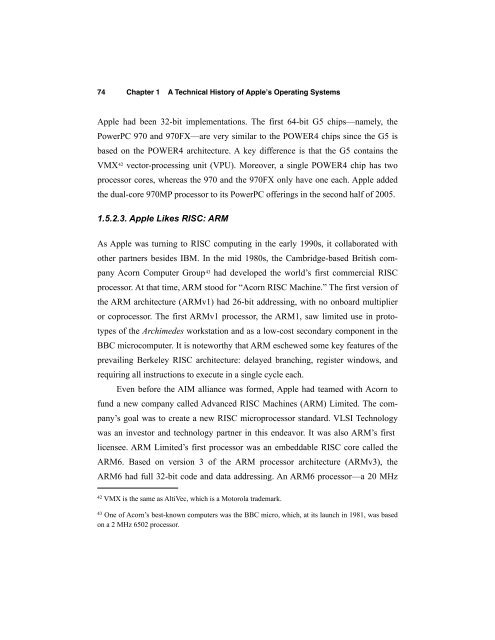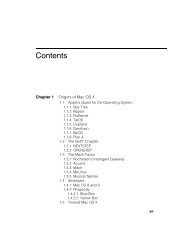A Technical History of Apple's Operating Systems - Mac OS X Internals
A Technical History of Apple's Operating Systems - Mac OS X Internals
A Technical History of Apple's Operating Systems - Mac OS X Internals
Create successful ePaper yourself
Turn your PDF publications into a flip-book with our unique Google optimized e-Paper software.
74 Chapter 1 A <strong>Technical</strong> <strong>History</strong> <strong>of</strong> Apple’s <strong>Operating</strong> <strong>Systems</strong><br />
Apple had been 32-bit implementations. The first 64-bit G5 chips—namely, the<br />
PowerPC 970 and 970FX—are very similar to the POWER4 chips since the G5 is<br />
based on the POWER4 architecture. A key difference is that the G5 contains the<br />
VMX 42 vector-processing unit (VPU). Moreover, a single POWER4 chip has two<br />
processor cores, whereas the 970 and the 970FX only have one each. Apple added<br />
the dual-core 970MP processor to its PowerPC <strong>of</strong>ferings in the second half <strong>of</strong> 2005.<br />
1.5.2.3. Apple Likes RISC: ARM<br />
As Apple was turning to RISC computing in the early 1990s, it collaborated with<br />
other partners besides IBM. In the mid 1980s, the Cambridge-based British com-<br />
pany Acorn Computer Group 43 had developed the world’s first commercial RISC<br />
processor. At that time, ARM stood for “Acorn RISC <strong>Mac</strong>hine.” The first version <strong>of</strong><br />
the ARM architecture (ARMv1) had 26-bit addressing, with no onboard multiplier<br />
or coprocessor. The first ARMv1 processor, the ARM1, saw limited use in proto-<br />
types <strong>of</strong> the Archimedes workstation and as a low-cost secondary component in the<br />
BBC microcomputer. It is noteworthy that ARM eschewed some key features <strong>of</strong> the<br />
prevailing Berkeley RISC architecture: delayed branching, register windows, and<br />
requiring all instructions to execute in a single cycle each.<br />
Even before the AIM alliance was formed, Apple had teamed with Acorn to<br />
fund a new company called Advanced RISC <strong>Mac</strong>hines (ARM) Limited. The com-<br />
pany’s goal was to create a new RISC microprocessor standard. VLSI Technology<br />
was an investor and technology partner in this endeavor. It was also ARM’s first<br />
licensee. ARM Limited’s first processor was an embeddable RISC core called the<br />
ARM6. Based on version 3 <strong>of</strong> the ARM processor architecture (ARMv3), the<br />
ARM6 had full 32-bit code and data addressing. An ARM6 processor—a 20 MHz<br />
42 VMX is the same as AltiVec, which is a Motorola trademark.<br />
43 One <strong>of</strong> Acorn’s best-known computers was the BBC micro, which, at its launch in 1981, was based<br />
on a 2 MHz 6502 processor.




